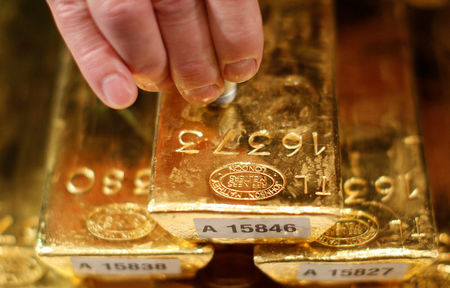Commodities
Gold prices rise past $2,400 with Fed, Middle East tensions in focus

Investing.com– Gold prices rose in Asian trade on Wednesday, encouraged by a softer dollar as traders awaited more cues on interest rate cuts from the Federal Reserve.
The yellow metal also benefited from some safe haven buying after the reported killing of Hamas leader Ismail Haniyeh by an Israeli strike in Iran pointed to a potential escalation in the war.
rose 0.3% to $2,419.11 an ounce, while expiring in December rose 0.5% to $2,463.85 an ounce by 01:09 ET (05:09 GMT).
Gold firms with Fed rate cut cues on tap
The yellow metal broke past the $2,400 an ounce level as traders pivoted out of the before the conclusion of a Fed meeting later in the day.
The central bank is widely expected to . But focus will be closely on any potential signals on interest rate cuts, following some soft inflation readings and dovish comments from Fed officials.
General consensus is largely for a 25 basis point cut in September. Lower rates benefit gold, given that they decrease the opportunity cost of investing in the yellow metal.
Israel-Hamas tensions benefit precious metals
Gold and other precious metals also benefited from a measure of safe haven buying, after multiple reports said Haniyeh was killed by an Israeli strike in Tehran.
The move presents a potential escalation in the Israel-Hamas war, which reached its ninth consecutive month with no signs of a ceasefire in sight.
The threat of an all-out war in the Middle East also grew, given that tensions between Iran and Israel were already elevated following missile attacks between the two earlier this year. Additionally, Israel carried out strikes against Iran-backed, Lebanon-based armed group Hezbollah earlier this week.
Among other precious metals, rose 0.7% to $976.75 an ounce, while rose 0.8% to $28.745 an ounce.
Copper rebounds on China stimulus hopes
Among industrial metals, copper prices rebounded from near four-month lows, as soft purchasing managers index data and positive government comments pushed up hopes for more stimulus measures in top importer China.
Benchmark on the London Metal Exchange rose 1.7% to $9,123.50 a tonne, while one-month rose 1.1% to $4.1368 a pound.
PMI data showed China’s shrank for a third consecutive month in July, while slowed.
The data came just after a meeting of China’s Politburo showed the government promising more stimulus measures, especially those aimed at boosting consumer sentiment.
Comments from the Politburo and the weak PMI readings ramped up hopes for more stimulus measures, although analysts warned that Beijing’s execution should be watched for more cues.
Commodities
Oil prices rise; U.S. crude inventories plunge, Russia-Ukraine truce eyed
Commodities
India’s Reliance to stop buying Venezuelan oil over US tariffs, sources say
Commodities
Oil prices climb on Venezuela supply worries

 Forex3 years ago
Forex3 years agoForex Today: the dollar is gaining strength amid gloomy sentiment at the start of the Fed’s week

 Forex3 years ago
Forex3 years agoUnbiased review of Pocket Option broker

 Forex3 years ago
Forex3 years agoDollar to pound sterling exchange rate today: Pound plummeted to its lowest since 1985

 Forex3 years ago
Forex3 years agoHow is the Australian dollar doing today?

 Cryptocurrency3 years ago
Cryptocurrency3 years agoWhat happened in the crypto market – current events today

 World3 years ago
World3 years agoWhy are modern video games an art form?

 Commodities3 years ago
Commodities3 years agoCopper continues to fall in price on expectations of lower demand in China

 Economy3 years ago
Economy3 years agoCrude oil tankers double in price due to EU anti-Russian sanctions























